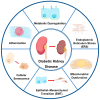Pathogenesis and Therapeutic Perspectives of Tubular Injury in Diabetic Kidney Disease: An Update
- PMID: 40564143
- PMCID: PMC12189843
- DOI: 10.3390/biomedicines13061424
Pathogenesis and Therapeutic Perspectives of Tubular Injury in Diabetic Kidney Disease: An Update
Abstract
Diabetic kidney disease (DKD), a well-characterized microvascular complication associated with the progression of diabetes mellitus, has been identified as the leading etiological factor contributing to the global burden of end-stage kidney disease (ESKD). Historically, DKD research has predominantly centered on glomerular mechanisms; however, recent studies have increasingly emphasized the critical role of tubular dysfunction. Extensive evidence has elucidated the key pathological drivers of tubular injury in DKD, encompassing metabolic dysregulation, pro-inflammatory signaling pathways, diverse cellular stress responses, and epithelial-mesenchymal transition (EMT). Furthermore, emerging mechanistic studies reveal that autophagic flux impairment and epigenetic memory formation collaboratively drive cellular senescence in DKD. Regarding the treatment of DKD, various hypoglycemic drugs, as well as hypotensive drugs, and microcirculatory improvers have garnered significant attention. Recently, stem cell-based interventions and precision gene editing techniques have unveiled novel therapeutic paradigms for DKD, fundamentally expanding the treatment arsenal beyond conventional pharmacotherapy. This review synthesizes updated insights into the pathogenesis of tubular injury in DKD and highlights promising therapeutic strategies for managing this condition.
Keywords: diabetic kidney disease; mechanism; therapeutics; tubular injury.
Conflict of interest statement
The authors declare no conflicts of interest.
Figures
Similar articles
-
Multidisciplinary management of diabetic kidney disease: a systematic review and meta-analysis.JBI Database System Rev Implement Rep. 2016 Jul;14(7):169-207. doi: 10.11124/JBISRIR-2016-003011. JBI Database System Rev Implement Rep. 2016. PMID: 27532796
-
The Role of miR-802 in Diabetic Kidney Disease: Diagnostic and Therapeutic Insights.Int J Mol Sci. 2025 Jun 7;26(12):5474. doi: 10.3390/ijms26125474. Int J Mol Sci. 2025. PMID: 40564936 Free PMC article. Review.
-
Pentoxifylline for diabetic kidney disease.Cochrane Database Syst Rev. 2012 Feb 15;2012(2):CD006800. doi: 10.1002/14651858.CD006800.pub2. Cochrane Database Syst Rev. 2012. PMID: 22336824 Free PMC article.
-
Protein restriction for diabetic kidney disease.Cochrane Database Syst Rev. 2023 Jan 3;1(1):CD014906. doi: 10.1002/14651858.CD014906.pub2. Cochrane Database Syst Rev. 2023. PMID: 36594428 Free PMC article.
-
Chinese herbal medicine and its active compounds in attenuating renal injury via regulating autophagy in diabetic kidney disease.Front Endocrinol (Lausanne). 2023 Mar 3;14:1142805. doi: 10.3389/fendo.2023.1142805. eCollection 2023. Front Endocrinol (Lausanne). 2023. PMID: 36942026 Free PMC article.
References
-
- Golestaneh L., Alvarez P.J., Reaven N.L., Funk S.E., McGaughey K.J., Romero A., Brenner M.S., Onuigbo M. All-cause costs increase exponentially with increased chronic kidney disease stage. Am. J. Manag. Care. 2017;23:S163–S172. - PubMed
Publication types
Grants and funding
- 2024YFC3044900/National Key Research and Development Program of China
- 2023BCB034/Key Research and Development Program of Hubei Province
- 82100794/National Natural Science Foundation of China
- 82200841/National Natural Science Foundation of China
- 82170773/National Natural Science Foundation of China
- 82300786/National Natural Science Foundation of China
- 81700603/National Natural Science Foundation of China
- 82370728/National Natural Science Foundation of China
- 82470771/National Natural Science Foundation of China
- 82400807/National Natural Science Foundation of China
- 81974097/National Natural Science Foundation of China
LinkOut - more resources
Full Text Sources


